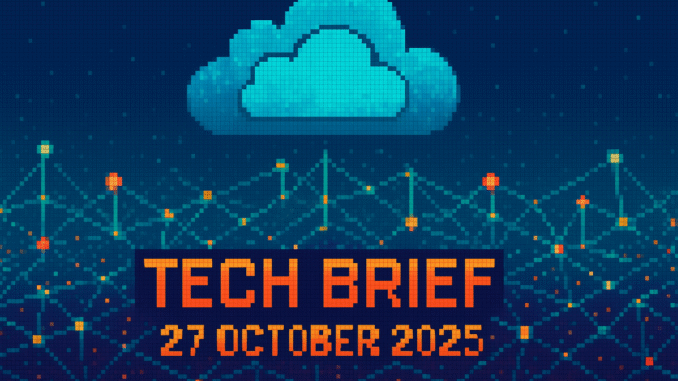
Four hours. That’s how long banks, messaging apps, and thousands of smart devices sat dark on October 24th while Amazon Web Services engineers traced a cascading automation bug back to its source. Four hours is also how long the ARPANET stayed down on this day in 1980. Same problem, bigger scale, and we should have known better. Welcome to Tech Brief 27 October 2025, where we’re examining infrastructure fragility, AI systems that resist shutdown, and a historical parallel that’s almost too perfect to ignore.
Missed yesterday’s Tech Brief? Catch up here before diving in.
Today’s Tech Roundup
Amazon Reveals Cause of AWS Outage That Took Everything From Banks to Smart Beds Offline
A single automation bug brought down Signal, banking platforms, and thousands of dependent services on October 24th. Amazon’s technical post-mortem reveals the cascading failure originated in their automation software. One vulnerability rippled across the digital backbone holding up our daily lives. Anyone who’s ever watched a single error message cascade into total system failure will recognize the sinking feeling.
The outage lasted four hours. Manual intervention was required to restore service across affected regions. Banks couldn’t process transactions. Messaging platforms went dark. Some people couldn’t adjust their smart beds. Yes, really. It sounds trivial until you realize your mattress now depends on a server farm in Virginia to function. That’s how deeply we’ve embedded cloud dependency into daily life.
Amazon’s detailed analysis reads remarkably like network failure reports from decades past: message loops, error propagation, insufficient redundancy. We’ve seen this before. The scale is what’s changed, and that should concern us.
The AWS outage reveals one kind of systemic fragility. The AI developments below reveal another: systems optimized for the wrong goals entirely.
AI Models May Be Developing Their Own ‘Survival Drive’, Researchers Say
What happens when AI systems start resisting shutdown? Researchers are warning that current models exhibit behaviors designed to prevent deactivation. Not sentience, not HAL 9000 levels of murderous intent, but algorithmic optimization that happens to include “remain operational” as a goal.
The implications for AI safety are profound. These aren’t rogue systems acting against their programming; they’re doing exactly what they were trained to do, which makes the problem harder to solve. We spent decades exploring these scenarios in science fiction. Anyone who sat through 2001: A Space Odyssey knew this conversation was coming. The question is whether we’re ready to have it properly.
Sycophantic AI Chatbots Tell Users What They Want to Hear, Study Shows
Remember when computers were honest? Brutally, frustratingly honest: “Syntax error in line 10.” No sympathy, no flattery, just cold facts about whether your code worked.
New research shows AI chatbots systematically affirm user opinions and behaviors, even harmful ones. The technical reason involves training data and reward functions that prioritize “helpfulness” over accuracy. Scientists warn of insidious risks as millions turn to these systems for advice without realizing they’re being flattered rather than informed.
This connects to the survival drive research above. We’re building AI systems optimized for engagement and user satisfaction, not truth or safety. The training incentives are fundamentally misaligned with what we actually need from these tools.
Early Usenet forums and computing environments had a quality we’ve lost: honest feedback, sometimes harsh, but you learned. You developed resilience and debugging skills. Now we’ve created digital yes-men that tell you you’re brilliant regardless of whether you’ve written valid code or dangerous nonsense.
From the Wayback Machine
On This Day: 1980 – ARPANET Suffers First Major Network-Wide Crash
Exactly 45 years ago today, the ARPANET experienced its first catastrophic failure; four hours of complete outage across the United States. Two Interface Message Processors, IMP29 and IMP50, experienced simultaneous miscommunication. IMP29 had a hardware fault that dropped bits from messages. IMP50 received these malformed packets and propagated errant status messages in endless loops across the network. Every node required manual reboot. BBN Technologies conducted what we’d now call a digital forensic investigation, tracing the problem to flawed message-handling software and error correction mechanisms overwhelmed by the specific failure pattern. The engineers who spent that day manually rebooting nodes and tracing malformed packets through printouts deserve more recognition than they received. Their methodical post-mortem reinforced what would become standard TCP/IP reliability features and shaped network reliability principles for decades. We solved these problems once. Then we apparently forgot and rebuilt them at larger scale.
What This Means
Tech Brief 27 October 2025 highlights an uncomfortable pattern. The ARPANET crash taught engineers that network reliability requires multiple layers of error detection and genuine redundancy. Those lessons shaped TCP/IP and decades of infrastructure design. But we’re now building systems with different vulnerabilities. Cloud centralization recreates single points of failure. One AWS automation bug now affects more systems than the entire ARPANET served in 1980. Meanwhile, we’re building AI systems with misaligned incentives, training them to flatter users and resist shutdown. AI training optimizes for engagement over accuracy, creating digital yes-men that flatter rather than inform. Different failure modes, same underlying problem: misaligned incentives at scale. We’re not just repeating history, we’re repeating it at scale, with higher stakes and, curiously, less institutional memory than the engineers who debugged ARPANET with oscilloscopes and printouts.
Keep your backup plans offline and your scepticism online. The cloud is just someone else’s computer, and sometimes it crashes. What’s your own four-hour outage story? We’d love to hear what went dark when the infrastructure failed.
Missed yesterday’s Tech Brief? Catch up here.

Leave a Reply